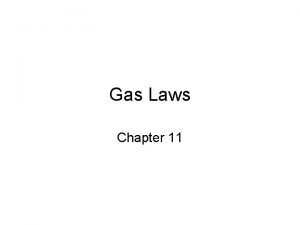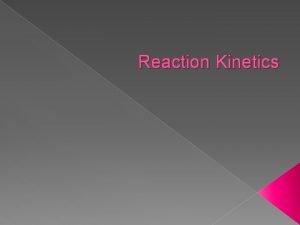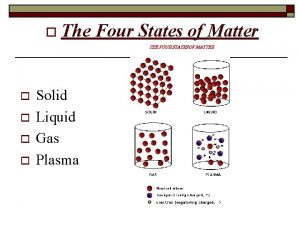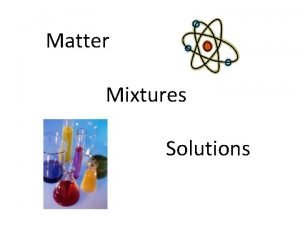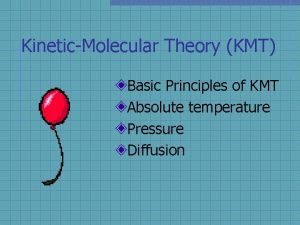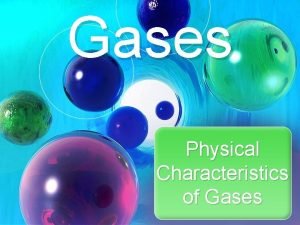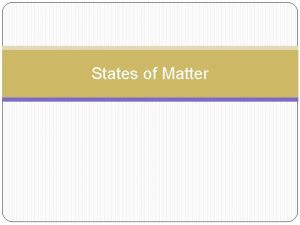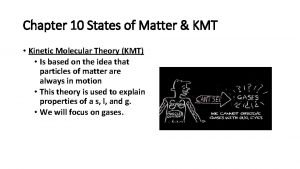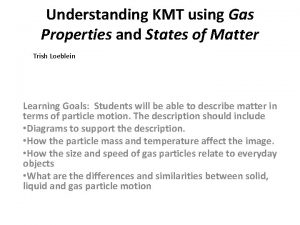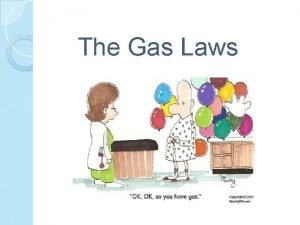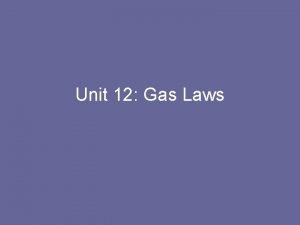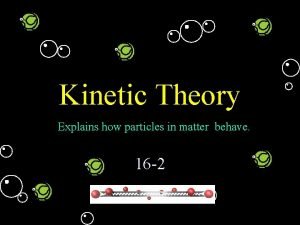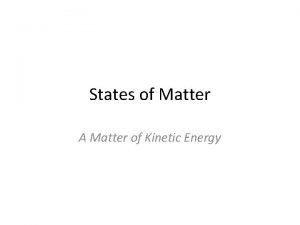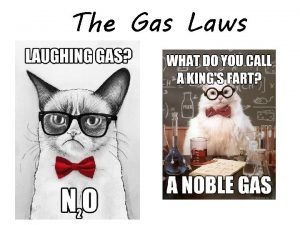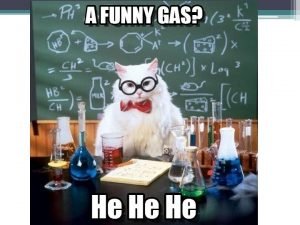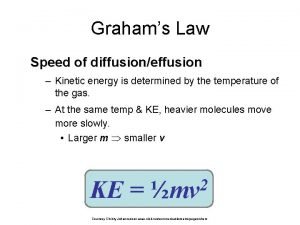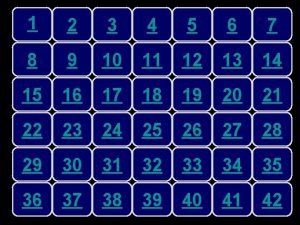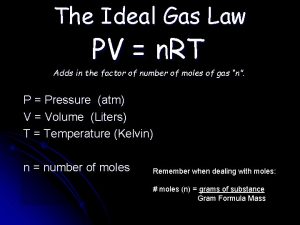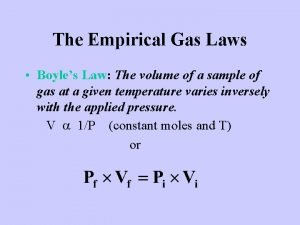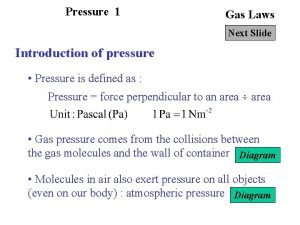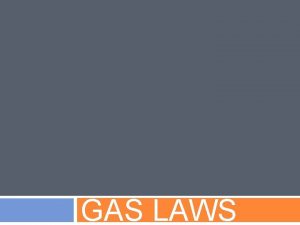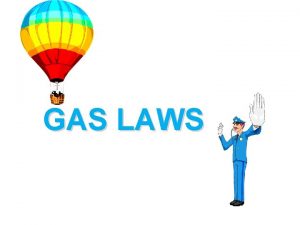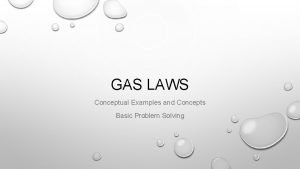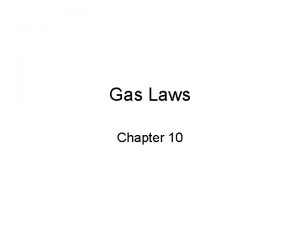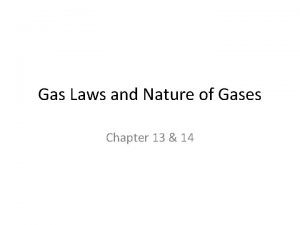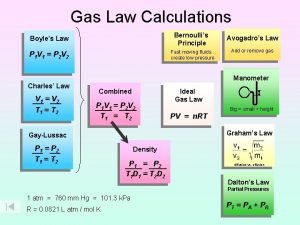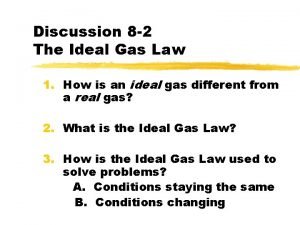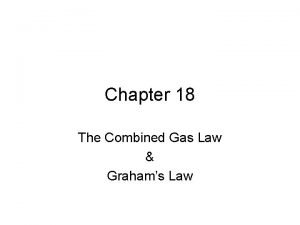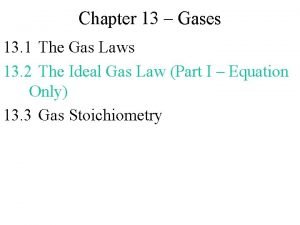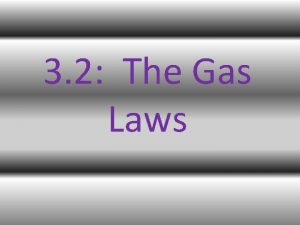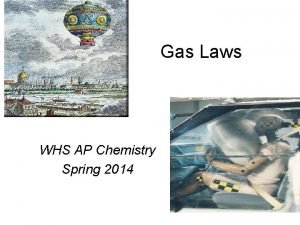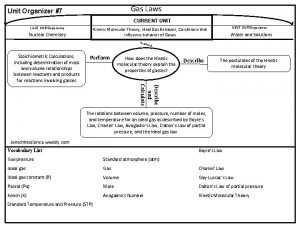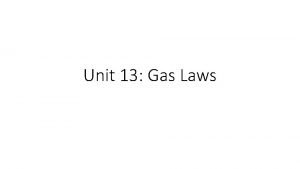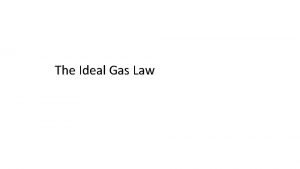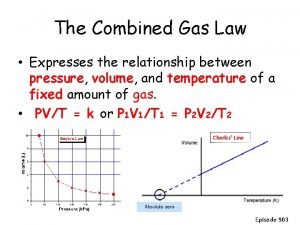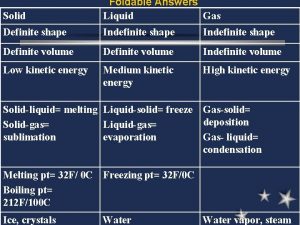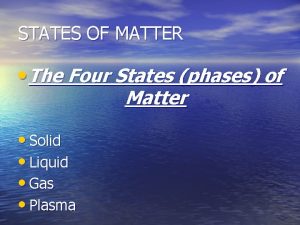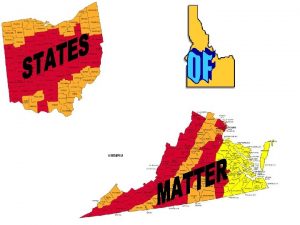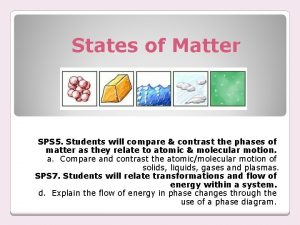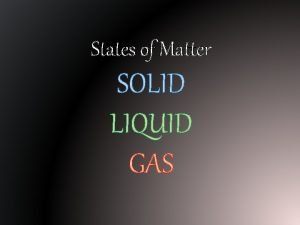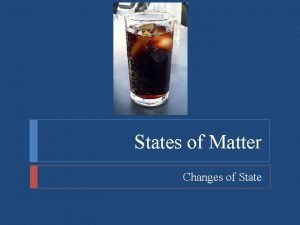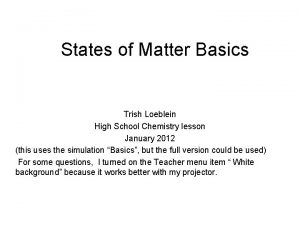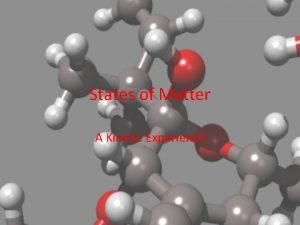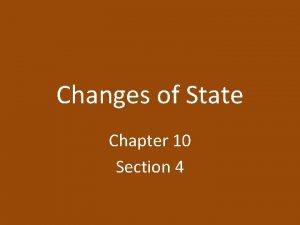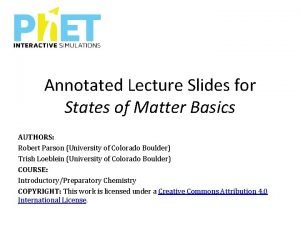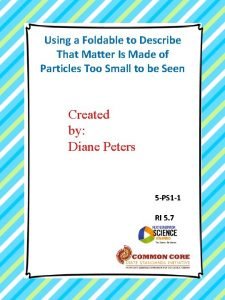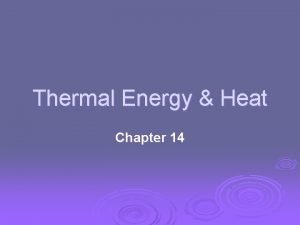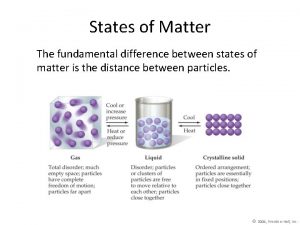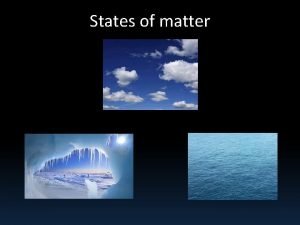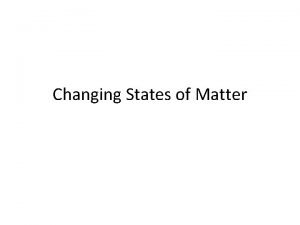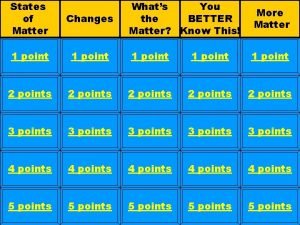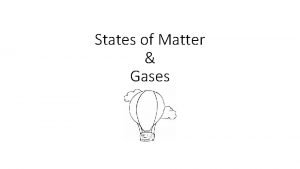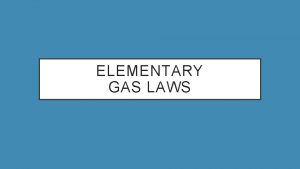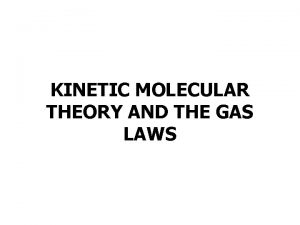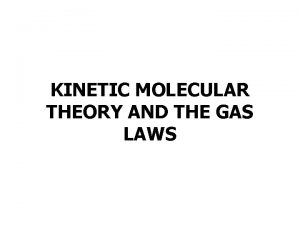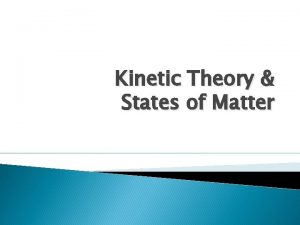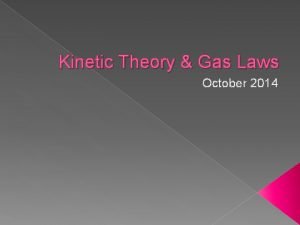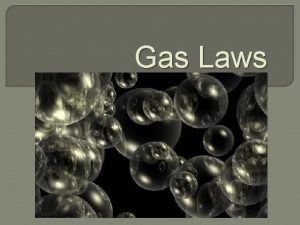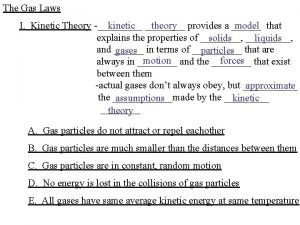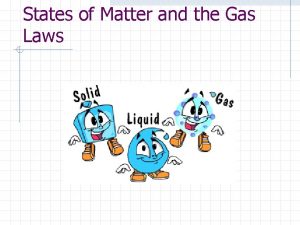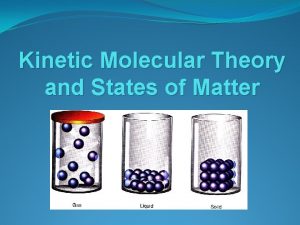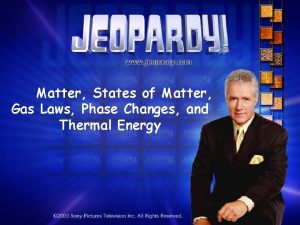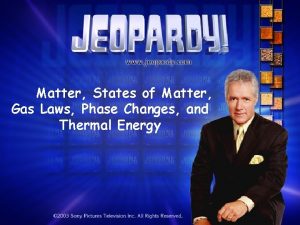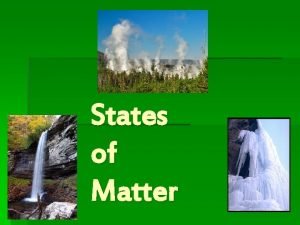KMT and Gas Laws States of Matter Kinetic













































































- Slides: 77

KMT and Gas Laws States of Matter, Kinetic Molecular Theory, Diffusion, Properties of Gases, and Gas Laws

Standards 4. The kinetic molecular theory describes the motion of atoms and molecules and explains the properties of gases. As a basis for understanding this concept: a. Students know the random motion of molecules and their collisions with a surface create the observable pressure on that surface. 4. b. Students know the random motion of molecules explains the diffusion of gases. 4. c. Students know how to apply the gas laws to relations between the pressure, temperature, and volume of any amount of an ideal gas or any mixture of ideal gases. 4. d. Students know the values and meanings of standard temperature and pressure (STP). 4. e. Students know how to convert between the Celsius and Kelvin temperature scales. 4. f. Students know there is no temperature lower than 0 Kelvin. 4. g. * Students know the kinetic theory of gases relates the absolute temperature of a gas to the average kinetic energy of its molecules or atoms. 4. h. * Students know how to solve problems by using the ideal gas law in the form PV = n. RT. 4. i. * Students know how to apply Dalton’s law of partial pressures to describe the composition of gases and Graham’s law to predict diffusion of gases.



States of Matter Deposition Sublimation Plasma it on a z i n n o i at e D niz Io Con Gas den Boi sation ling Solid g iz n ee ing r F lt e M Liquid

Condensation (Gas Liquid)

Boiling (Liquid Gas)

Sublimation (Solid Gas)

Deposition (Gas Solid)

Freezing (Liquid Solid)

Melting (Solid Liquid)

Molecular Motion of Gases

Molecular Motion of Gases

KMT – Kinetic Molecular Theory • The path of any individual molecule could best be described as random.

Molecular Motion • The state of matter depends on how much energy (motion) the molecules, atoms, or ions have. • The state of matter also depends on how attracted the atoms, molecules, or ions are to each other.

Molecular Motion O O + H + Na State of Matter O Gas – + H – Cl Liquid Solid

Nonpolar molecules O O

Polar molecules + H O – H + H O – + H – + O + H

Ionic compounds – + Na – Cl Cl – Cl + Na – Cl Cl + Na

Molecular Twist and Stretch

Diffusion • Diffusion – when a substance spreads out in a gas or liquid. • Examples: 1. Perfume eventually reaching the far side of a room. 2. Kool-Aid dissolving into water.

Diffusion of Gases

Diffusion of Gases

Diffusion of Liquids

Temperature (T) • Kinetic energy is the energy of motion. • Temperature is defined as a measure of the average kinetic energy of the atoms or molecules.

Temperature (T) • There are two scales and an absolute unit. (degrees Fahrenheit, degrees Celsius, and Kelvin)

Temperature Scales Water Boils 212°F 100°C 373 K Human Body 98. 7°F 37°C 310 K Water Freezes 32°F 0°C 273 K

Temperature Scales Surface of Sun 9, 941°F 5, 505°C 5, 778 K Room Temp. 70°F 21°C 294 K Absolute Zero -460°F -273°C 0 K

Converting Temperatures • Fahrenheit Celsius °C = (°F – 32)×(5/9) • Celsius Fahrenheit °F = °C ×(9/5) + 32 • Celsius Kelvin K = °C + 273. 15

Absolute Zero • At Zero Kelvin (0 K or – 273. 15 °C), atoms and molecules stop moving. • There is no temperature lower than absolute zero (0 K).

Volume (V) • How much space is occupied by a fluid. Liquid Gas • Usually gases are measured in Liters (L)

Pressure (P) • Defined as force divided by area. • The force comes from atoms’ or molecules’ collisions with the wall of the container. • The greater the number of collisions or the more energy with each collision, the greater the pressure.

Pressure (P) • Defined as force divided by area. • The force comes from atoms’ or molecules’ collisions with the wall of the container. • The greater the number of collisions or the more energy with each collision, the greater the pressure.

Pressure Units Unit Atmospheres Unit Symbol atm 1 atm = -- Pascals Pa 101, 325 Pa Kilopascals k. Pa 101. 3 k. Pa Pounds per square inch Millimeters mercury lbs. or psi 14. 7 psi in. 2 mm Hg 760 mm Hg

Pressure 0 atm Outer Space (a vacuum) 0. 33 atm Top of Mt. Everest 1 atm Regular Atmosphere (at sea level) 1, 072 atm At the Bottom of Mariana Trench

Gas Properties Property Pressure Usual Unit Symbol P kilopascal k. Pa Volume V liters L Temperature T Kelvin K Moles n moles mol

STP = Standard Temperature and Pressure Temperature is 0°C = 273. 15 K and Pressure is 1 atm = 101. 3 k. Pa

Gas Laws • Most of the gas laws deal with taking a quantity of gas and changing one property (pressure, temperature, or volume) and predicting how the other properties will change in response.

Boyle’s Law When given a certain amount of gas, if you increase the pressure, the volume decreases. If you decrease the pressure, the volume increases. Mathematically: P 1 V 1 = P 2 V 2 P 1 V 1 = P 2 V 2

Boyle’s Law When given a certain amount of gas, if you increase the pressure, the volume decreases. If you decrease the pressure, the volume increases. Mathematically: P 1 V 1 = P 2 V 2 P 1 V 1 = P 2 V 2 This assumes a constant temperature (T)

Boyle’s Law Example Your nephew is playing with a balloon in the car as your family drives over a mountain pass. The balloon initially had a volume of 1 L when the car was at the bottom of the mountain (and the air pressure was 100 k. Pa). Now that your family is at the top the air pressure is 70 k. Pa. What is the new volume of the balloon? P 1 V 1 = P 2 V 2

Boyle’s Law Example P 1 = 100 k. Pa V 1 = 1 L P 2 = 70 k. Pa V 2 = ? P 1 V 1 = P 2 V 2 (100 k. Pa)(1 L) = (70 k. Pa) • V 2 100 k. Pa • L = 70 k. Pa • V 2 70 k. Pa 1. 43 L = V 2

Boyle’s Law Example Low P Normal P

Boyle’s Law Example Normal P V 1 = 1 L Low P V 2 = 1. 43 L

Charles’ Law When given a certain amount of gas, if you increase the temperature, the volume increases. If you decrease the temperature, the volume decreases. 1 2 Mathematically: You must use Kelvin temperatures! V = V T 1 T 2 V 1 V 2 = T 2 T 1

Charles’ Law When given a certain amount of gas, if you increase the temperature, the volume increases. If you decrease the temperature, the volume decreases. 1 2 Mathematically: You must use Kelvin temperatures! V = V T 1 T 2 V 1 V 2 = T 2 T 1 This assumes a constant pressure (P)

Charles’ Law Example If 1. 0 L of gas is contained within a piston at 27 ˚C (300 K), what will new volume be if the gas is cooled to -23 ˚C (250 K)? Assume that the pressure is constant. V 1 V 2 = T 2 T 1

Charles’ Law Example V 1 = 1. 0 L T 1 = 300 K V 1 V 2 = T 2 T 1 V 2 = ? T 2 = 250 K V 2 1. 0 L = 300 K 250 K V 2 1. 0 = (250) V 2 = 0. 83 L 300 250

Charles’ Law This assumes a constant pressure (P)

Charles’ Law This assumes a constant pressure (P)

Which Law? T 1 V 1 7) Oxygen gas. Tat 2 47 ˚C occupies a volume of 0. 5 L. To what temperature should the V 2 gas be lowered to bring the volume oxygen to 0. 2 L? Assume constant pressure. V 1 = V 2 T 1 T 2 Charles’ Law

Which Law? P 1 V 1 sample (N 2 O) occupies 9) A nitrous oxide a volume of 360 m. L when V 2 under 70 k. Pa of P 2 How much volume will it occupy pressure. at 420 k. Pa? Assume constant temperature. P 1 V 1 = P 2 V 2 Boyle’s Law

Gay–Lussac’s Law When given a certain amount of gas, if you increase the temperature, the pressure increases. If you decrease the temperature, the pressure decreases. 1 2 Mathematically: You must use Kelvin temperatures! P = P T 1 T 2 P 1 = T 2 T 1

Gay–Lussac’s Law When given a certain amount of gas, if you increase the temperature, the pressure increases. If you decrease the temperature, the pressure decreases. 1 2 Mathematically: You must use Kelvin temperatures! P = P T 1 T 2 P 1 = T 2 T 1 This assumes a constant volume (V)

Gay–Lussac’s Law Example A tire that has already been inflated to its maximum volume, T 1 begins a drive at a P 1 temperature of 300 K with an air pressure 2 air in the of 36 psi. During the hot day Pthe T 2 tire’s pressure increases to 42 psi. What will the new temperature be?

Gay–Lussac’s Law Example A tire that has already been inflated to its maximum volume, T 1 begins a drive at a P 1 temperature of 300 K with an air pressure 2 air in the of 36 psi. During the hot day Pthe T 2 tire’s pressure increases to 42 psi. What will the new temperature be? P 2 P 1 = T 2 T 1

Gay–Lussac’s Law Example P 1 = 36 psi T 1 = 300 K P 2 P 1 = T 2 T 1 P 2 = 42 psi T 2 = ? 36 psi 42 psi = T 2 300 K 42 (T 2) 0. 12 = (T 2) T 2 0. 12 (T 2) = 42 T 2 = 350 K 0. 12

Before After P 2 = 42 psi P 1 = 36 psi T 1 = 300 K T 2 = 350 K

Avogadro’s Law The volume of a gas at Standard Temperature and Pressure (STP) is directly proportional to the moles of the gas. V=kn # of moles At STP there are 22. 4 L per mole of gas.

Avogadro’s Law Example How many liters will 3 moles of gas occupy at STP? V=kn L V = (22. 4 mol )(3 mol) V = 67. 2 L

Combined Gas Law This combines Boyle’s, Charles’, and Gay-Lussac’s Gas Laws. Mathematically: P 1 V 1 = P 2 V 2 T 1 T 2 Cancel out the properties that remain constant.

Combined Gas Law This combines Boyle’s, Charles’, and Gay-Lussac’s Gas Laws. Mathematically: P 1 V 1 = P 2 V 2 T 1 T 2 Cancel out the properties that remain constant.

Combined Gas Law Example P 1 = 50 k. Pa V 1 = ? T 1 = 300 K P 1 V 1 P 2 V 2 = T 1 T 2 P 2 = 200 k. Pa V 2 = 0. 12 L T 2 = 400 K (50)V 1 (200)(0. 12) = (400) 300 (V 1)0. 167 = 0. 06 0. 167 V 1 = 0. 36 L

Ideal Gas Law If we know 3 of the 4 gas properties (P, V, T, and n) we can solve for the missing one by using the formula: PV = n. RT R is called the gas constant. • L k. Pa R = 8. 314 mol • K

Ideal Gas Law A cylinder is filled with 0. 2 moles of gas. The sealed cylinder has a volume 3. 0 L and is heated with 3, 000 J to a temperature of 300 K. What is the pressure inside the cylinder? PV = n. RT k. Pa L P • (3. 0 L) = (0. 2 mol)(8. 314 )(300 K) • P • (3. 0 L) = 499 k. Pa • L 3. 0 L P = 166 k. Pa mol • K

Gas Laws Summary Formula Boyle’s Law Charles’ Law Gay-Lussac’s Law Avogadro’s Law Combined Gas Law Ideal Gas Law P 1 V 1 = P 2 V 1 V 2 = T 1 T 2 P 1 P 2 = T 1 T 2 V=kn P 1 V 1 P 2 V 2 = T 1 T 2 PV = n. RT

What is the change in volume? CH 4(g) + H 2 O (g) CO (g) + 3 H 2 (g) Methane + water carbon monoxide hydrogen +

Vapor Pressure For a liquid as the temperature increases, its vapor pressure increases. When the vapor pressure is equal to the external pressure, the liquid has reached its boiling point. Effects of Vapor Pressure: • Warm water evaporates faster than cold water. • At higher altitudes, water boils at a lower temperature.

Dynamic Equilibrium Dynamic equilibrium occurs when the rate of condensation equals the rate of evaporation Liquid condensation Vapor (or gas) Note: the amounts of liquid and vapor can be completely different.

Dalton’s Law of Partial Pressures The total pressure exerted by a mixture of gases is equal to the sum of all partial pressures exerted by each individual gas. Ptot = P 1 + P 2 + P 3 + … For example: our classroom Ptot = PN 2 + PO 2 + PAr + PCO 2 + PH 2 O + … 1 atm = 0. 79 atm + 0. 19 atm + 0. 01 atm + 0. 003 atm +…

Graham’s Law of Diffusion • From the simulations we saw, that lighter gas molecules move faster than heavier gas molecules. • If we want to directly compare the speeds of gas molecules we can use: These are the average molecular speeds v. A = v. B MB MA These are the molar masses


H He Li Be B C N O F Na Mg Al Si P S Cl Ar K Ca Ne Br Kr I Xe

H He Li Be B C N O F Na Mg Al Si P S Cl Ar K Ca Ne Br Kr I Xe


4 e– in valence shell

Gas Laws Summary Gas Law Formula Boyle’s Law P 1 V 1 = P 2 V 2 Charles’ Law Avogadro’s Law V 1 V 2 = T 1 T 2 P 1 = P 2 T 1 T 2 V=kn Ideal Gas Law PV = n. RT Gay-Lussac’s Law
 Kmt gas laws
Kmt gas laws The kinetic theory of matter states that
The kinetic theory of matter states that Solid
Solid States of matter solid liquid gas
States of matter solid liquid gas Kmt chem
Kmt chem Kmt postulates
Kmt postulates Kmt
Kmt Kmt
Kmt Kmt sct
Kmt sct Avogadro's law
Avogadro's law Relation between pressure and kinetic energy of gas
Relation between pressure and kinetic energy of gas Useless laws weaken the necessary laws
Useless laws weaken the necessary laws Kinetic theory of matter definition
Kinetic theory of matter definition Define kinetic theory of matter
Define kinetic theory of matter Buoyancyability
Buoyancyability Particle theory evaporation
Particle theory evaporation What is a kinetic theory of matter
What is a kinetic theory of matter Is boyle's law direct or indirect
Is boyle's law direct or indirect White matter nervous system
White matter nervous system Gyrus and sulcus function
Gyrus and sulcus function Gray matter and white matter
Gray matter and white matter Telencephalon
Telencephalon Chapter 11 - states of matter: liquids and solids
Chapter 11 - states of matter: liquids and solids Postulate of kinetic theory of gases
Postulate of kinetic theory of gases Kinetic energy of gas formula
Kinetic energy of gas formula Graham's law of effusion
Graham's law of effusion Passed in several western states, granger laws
Passed in several western states, granger laws Concept map of matter solid liquid and gas
Concept map of matter solid liquid and gas Gas laws crash course
Gas laws crash course Stp gas laws
Stp gas laws The combined gas law
The combined gas law All the gas laws
All the gas laws Different gas laws
Different gas laws Charles law balloon
Charles law balloon Gas law conceptual questions
Gas law conceptual questions Boyle's law finding v2
Boyle's law finding v2 Combined gas law
Combined gas law 3 gas laws
3 gas laws Different gas laws
Different gas laws Combined gas law worksheet
Combined gas law worksheet 13-4 practice problems chemistry
13-4 practice problems chemistry Boyle's law states that
Boyle's law states that Empirical gas laws
Empirical gas laws Ap chemistry gas laws
Ap chemistry gas laws Gas laws graphic organizer
Gas laws graphic organizer Gas laws hot air balloon
Gas laws hot air balloon Jacques charles' law
Jacques charles' law Gas law equations
Gas law equations Empirical gas laws
Empirical gas laws Gas variable relationships
Gas variable relationships Pv=nrt density
Pv=nrt density Indefinite shape
Indefinite shape Gas law
Gas law Difference between ideal gas and real gas
Difference between ideal gas and real gas Phases of matter foldable
Phases of matter foldable Four phases of matter
Four phases of matter Four states of matter
Four states of matter 5 states of matter
5 states of matter Which state of matter has the most thermal energy
Which state of matter has the most thermal energy Changing state
Changing state Phet states of matter basics
Phet states of matter basics 5 states of matter
5 states of matter Venn diagram of states of matter
Venn diagram of states of matter What were the 11 free states
What were the 11 free states Northern and southern states
Northern and southern states Classification of matter section 1 composition of matter
Classification of matter section 1 composition of matter Chapter 12 states of matter
Chapter 12 states of matter Chapter 10 review states of matter section 4
Chapter 10 review states of matter section 4 States of matter: basics
States of matter: basics States of matter foldable
States of matter foldable Thermal energy in states of matter
Thermal energy in states of matter Thermal energy in states of matter
Thermal energy in states of matter The fundamental difference between states of matter is the
The fundamental difference between states of matter is the Stayes of matter
Stayes of matter Classification of matter section 1 composition of matter
Classification of matter section 1 composition of matter Mind map on states of matter
Mind map on states of matter Better matter
Better matter States of matter
States of matter
